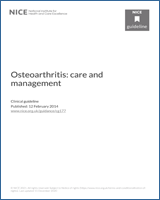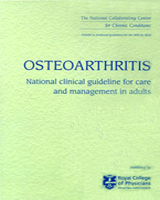All rights reserved. No part of this publication may be reproduced in any form (including photocopying or storing it in any medium by electronic means and whether or not transiently or incidentally to some other use of this publication) without the written permission of the copyright owner. Applications for the copyright owner’s written permission to reproduce any part of this publication should be addressed to the publisher.
NCBI Bookshelf. A service of the National Library of Medicine, National Institutes of Health.
National Collaborating Centre for Chronic Conditions (UK). Osteoarthritis: National Clinical Guideline for Care and Management in Adults. London: Royal College of Physicians (UK); 2008. (NICE Clinical Guidelines, No. 59.)
This publication is provided for historical reference only and the information may be out of date.
What are the factors influencing, and methods of improving, adherence to osteoarthritis therapies?
Many therapies for osteoarthritis, for example, paracetamol or muscle strengthening, will have benefits but are often only used by people for a limited duration. For example, when using muscle strengthening there is little information on how optimal contact with a physiotherapist can be achieved, and how this can be sustained over the long term for a chronic condition like osteoarthritis.
What are the short- and long-term benefits of non-pharmacological and pharmacological osteoarthritis therapies in the very elderly?
There is very little data on the use of all osteoarthritis therapies (non-pharmacological and pharmacological) in the very elderly. This is of increasing concern with our ageing population. For example, exercise therapies may need to be tailored, and use of opioids requires more careful titration.
What are the benefits of combination (non-pharmacological and pharmacological) osteoarthritis therapies and how can they be included in clinically useful, cost-effective algorithms for long term use?
Most people with osteoarthritis get a combination of non-pharmacological and pharmacological therapies, but most of the trial evidence only evaluates single therapies. Often trials are of short duration (for example, 6 weeks) when people may live with osteoarthritis for more than 30 years! The optimal content and frequency of review by front-line clinicians is not known.
What are the predictors of good outcome following total and partial joint replacement?
Although joint replacement provides very good pain relief for many people with osteoarthritis, it does not provide a good outcome in a substantial number of people. It would be very useful to have preoperative tools to help choose people who would derive most benefit.
What are the benefits of individual and combination osteoarthritis therapies in people with multiple joint region pain?
Most people over 55 have more than one painful joint, for example, it is common to have osteoarthritis in both knees, and there may be excess strain put on the upper limbs if painful knee osteoarthritis is present. Most trials of osteoarthritis therapies have examined efficacy of therapies on a single joint.
Is it possible to identify subsets of people with osteoarthritis in whom existing treatments are more beneficial and cost effective (for example, acupuncture or hyaluronans)?
Osteoarthritis is complex in terms of pain and range of structural pathology. It may be that certain treatments have increased efficacy if targeted to subsets of the general osteoarthritis population. At present, there are few useful subclassifications of osteoarthritis.
Who are the people with osteoarthritis who would benefit from devices (including footwear, insoles, braces and splints)?
There are a range of devices available to help people with osteoarthritis, but there are very few trials to demonstrate their efficacy, and in particular little data to guide health professionals on which people would benefit most from these aids.
What are effective strategies for weight loss in people with painful knee or hip osteoarthritis, and how much weight should they lose?
Weight loss appears effective for reducing pain in overweight people with osteoarthritis, but losing weight is very difficult and probably requires multiple strategies to be effective. Taking exercise when joints are already very painful may be extremely difficult.
What are the benefits of treatment of comorbidities (for example, depression) in people with osteoarthritis?
Pain is a complex problem and many of the effect sizes for treatments listed in this guideline are small to moderate. As well as obesity, there are many other comorbid conditions in people with osteoarthritis, many of which may influence pain and quality of life. How treatment of these conditions influences outcomes has not been explored.
What social and psychological outcome measures are the most effective indicators to identify patient-perceived benefits of effective self-management strategies for osteoarthritis?
For individuals with knee and hip osteoarthritis, what benefits can be achieved using a patient-centred approach to information giving and pain management compared with group self-management programmes (as measured by pain, changes in prescriptions for symptom control, positive health-seeking behaviours and participation in activities of daily living, quality of life)?
- Areas for future research - OsteoarthritisAreas for future research - Osteoarthritis
- SRX24276539 (1)SRA
- Homo sapiens clone HsUT00699452 NES (NES) gene, 3' UTRHomo sapiens clone HsUT00699452 NES (NES) gene, 3' UTRgi|929047948|gb|KT584508.1|Nucleotide
- PREDICTED: Castor canadensis calpain 3 (Capn3), transcript variant X1, mRNAPREDICTED: Castor canadensis calpain 3 (Capn3), transcript variant X1, mRNAgi|1147289929|ref|XM_020170209.1|Nucleotide
- Luciobarbus rifensis isolate AT22074 cytochrome b (cytb) gene, partial cds; mito...Luciobarbus rifensis isolate AT22074 cytochrome b (cytb) gene, partial cds; mitochondrialgi|2019278852|gb|MW588357.1|Nucleotide
Your browsing activity is empty.
Activity recording is turned off.
See more...

